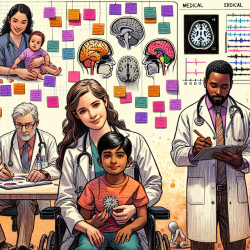In the dynamic field of speech-language pathology, the treatment of stuttering has undergone significant transformations, particularly with the advent of new technologies. The journey of stuttering therapy, from traditional methods to the incorporation of state-of-the-art techniques, offers a fascinating glimpse into the evolution of speech therapy practices. This blog post delves into the insights and outcomes presented in the research article "Stuttering Therapy: Disciples of the New Technologies" by R.M. Kroll, exploring how practitioners can enhance their skills by implementing these findings or by engaging in further research.
The late 1970s marked a pivotal moment in stuttering therapy, introducing structured programs that utilized empirically derived procedures alongside modern instrumentation. This shift represented a departure from the era of ad hoc therapy techniques, ushering in a new age where clinicians could rely on a logical and systematic series of procedures to guide their therapy sessions. The Precision Fluency Shaping Program (PFSP), highlighted in Kroll's work, exemplifies this innovative approach, offering an intensive 3-week regimen designed to help stutterers achieve and transfer fluent speech.
However, the evolution of stuttering therapy has not been without its challenges. As the field has progressed, it has become increasingly clear that a one-size-fits-all approach is insufficient. The complexity of stuttering as a disorder necessitates that therapy be tailored to the individual, taking into account the unique needs and circumstances of each patient. This realization underscores the importance of making the therapy fit the patient, rather than the reverse.
One of the most compelling aspects of Kroll's commentary is the emphasis on the need for ongoing professional development and the cultivation of a critical, scientific mindset among clinicians. The landscape of stuttering therapy is one of continual learning and adaptation, where practitioners must be prepared to evaluate, analyze, and adjust their approaches based on the latest research and their own clinical observations.
The rise of new technologies in stuttering therapy has not only improved patient outcomes but has also raised questions and generated debate within the professional community. Kroll's reflections on the sense of competition and defensiveness among proponents of different treatment programs serve as a cautionary tale, reminding us of the importance of maintaining open lines of communication and collaboration. In the pursuit of advancing stuttering therapy, it is crucial that professionals remain committed to sharing knowledge, challenging assumptions, and embracing a diversity of approaches.
Moreover, Kroll's experience highlights the potential pitfalls of media representation and the importance of managing public perceptions of stuttering therapy. The allure of "glitzy" and intensive programs can overshadow the reality that stuttering treatment is a complex, multifaceted process that may not be suitable for all individuals. As practitioners, it is our responsibility to ensure that our communication with the public accurately reflects the nuanced nature of stuttering therapy and the varied experiences of those who stutter.
In conclusion, "Stuttering Therapy: Disciples of the New Technologies" serves as a valuable resource for speech-language pathologists seeking to refine their practice and improve patient outcomes. By embracing the lessons learned from the past and remaining open to the possibilities of the future, clinicians can continue to make strides in the treatment of stuttering. As we move forward, let us commit to a path of continuous learning, collaboration, and innovation, ensuring that our approaches to stuttering therapy are as diverse and dynamic as the individuals we serve.
To read the original research paper, please follow this link: Stuttering Therapy: Disciples of the New Technologies.










